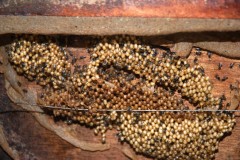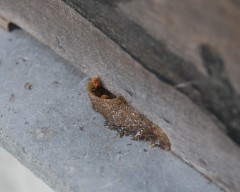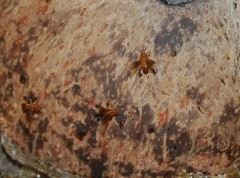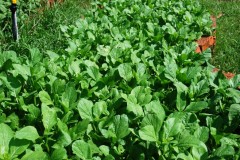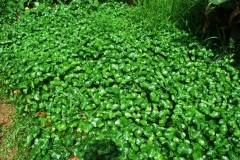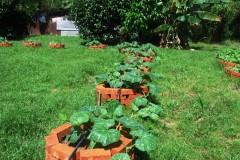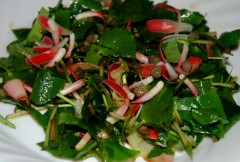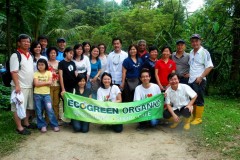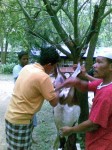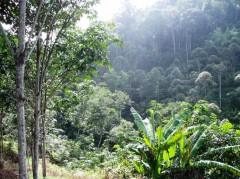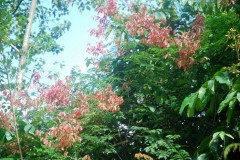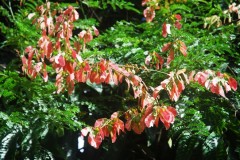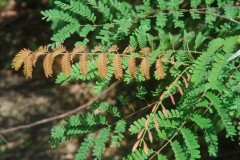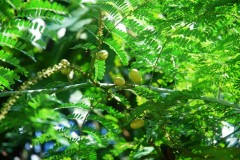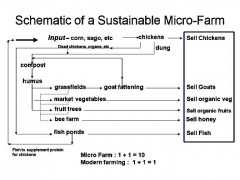Jan 04, 2010
Stingless Bees
We failed with the Italian bees. They seem to invite mites and worse, they all fall prey to various birds, especially the swifts.
We are now keeping local honey bees. However, they are more aggressive and the stings are very painful.
Now, we have found stingless bees in the farm in many places and are now trying to domesticate them. There are at least three species that we have seen so far, producing a very rich aromatic honey.
These are the size of gnats and produce a dark colored very sweet honey.
Below are red colored stingless bees which are the size of flies. They produce copious amounts of propolis.
The bees quickly seal up the entrance of the box with propolis.
The transferred bees are quickly acclimatising themselves to their new homes; coconut shells.
These bees are ideal for urban homes. They are stingless and produce better quality honey than the commercial honey that we have become used to.
Click on the pics for close-ups
13:36 Posted in Blog | Permalink | Comments (0) | Tags: trigona, meliponines, kelulut, honey bees
Dec 10, 2009
Raised Beds - It is Cost Effective!
Raised beds incorporating design to maximise planting areas and reducing energy input was developed by the Permaculture movement. At DQ, we have added a small innovation, i.e. to make it expandable.
The expandable raised beds are now producing their third harvest:
This is bayam pasir again. We rotated the bed used.
And this is sawi bunga, a brassica chinensis var. It will be ready for harvesting cum thinning in a few days time when the flowers emerge.
There has been no purchased input and minimal on-farm produced inputs. When we replanted, we just top up with some compost, seed the beds and add mulch. We of course rotated beds. Once a week we spray some herbal extracts and our Teh Qi (compost tea) spray. That's about it. No weeding at all was necessary.
If you click on the pictures for a close-up, you can see minimal insect damage. And the plants are sweet and aromatic.
The office staff and their children came to help themselves to the vegetables and herbs, and to have a picnic at the farm.
The next bed that we will expand to, will be used to plant a herb, most probably basil as companion plant. In this way, we will reduce even further insect problems.
Here are some pictures of raised beds elsewhere in the farm:
Lush gotu kola or pegaga raised bed.
Healthy pumpkin plants under the mid-day sun on raised beds.
Watermelon plants on raised beds.
11:11 Posted in Permaculture | Permalink | Comments (0) | Tags: raised beds, key hole garden, permaculture, dark colored plants
Dec 07, 2009
The Internationalisation of Food
The recipes for many of our local vegetables, leaves and herbs can be 'updated' to suit modern taste-buds. This will reduce our dependence on imported fresh food or to pay high prices for transplanting those vegetables and herbs here to grow them.
Due to globalised marketing our perception of what is good and delicious food have changed, and become more 'internationalised'; leading to the possible demise of many local 'heritage' edible plants.
In the sixties and even as late as the seventies, a 'delicious' chicken was aromatic and 'sweet' just from the meat alone (of course you may have to boil the bird for an hour or so!).
Nowadays, a 'delicious' chicken means one that is tender and juicy, and the taste is from the marinate and spices used. Modern marketing have changed our perception and defination of a delicious chicken to accept the bland bird that comes out of factory farms. A bird that has excessive fats (from feeding the birds high grains diet and vegetable oils) is now spun to mean 'tender', and a bird that has both high fats and water content, is now 'juicy', never mind that it is tasteless and a nutritional disaster.
We go into a supermarket and march out with hydrophonically grown vegetables and herbs like arugulas, radicchio, etc. without realising that we have the greatest diversity of edible plants just outside our doors. They present to our senses a wide variety of aromas and tastes, far more than the western vegetables and herbs can ever deliver. And they cost a fraction of the costs of the foreign stuff.
Just go to the pasar tani (farmer's market) and look at the number of 'ulams' (plants that can be eaten raw) to choose from.
And upgrade them to modern taste-buds.
Here's an example from our farm:
Pluck a few young leaves from a lemon tree.
Take some petals from a kantan flower.
And a generous helping of pegaga (gotu kola) with the stalks ( crunchy ).
I like to cut them up to slices. Then add some balsamic vinegar, generous amount of extra virgin olive oil, some himalayan rock salt (less sodium) and pepper. And if you are a bit adventurous, add one passion fruit and some 'dijonaise' (dijon mustard and mayo, half/half) - that's real gourmet stuff we have here, courtesy of yours truly.
There will be an explosion of flavours and fragrances that will rival any on offer in a 5-star hotel.
18:54 Posted in Slow Food / Rare Receipes | Permalink | Comments (0) | Tags: slow food, kantan, pegaga
Nov 29, 2009
EcoGreen came visiting
The owners of one of the most established organic shops and restaurants, EcoGreen Organic, came visiting with some of their customers. We don't farm in 'secret' and we don't have 'show' farms. And we don't believe organic farming should have anything to do with contract farming. WYSIWYG!
Here's a group photo.
The owner and head chef of EcoGreen, Sherene with her daughter Li Hua, up close with our free-range, grassfed chickens.
Brig Gen (R) Dato' Adnan, who owns a training camp near DQ Farm and Mr. Wong the owner and CEO of EcoGreen smelling the 8 year old litter which all visitors must submit themselves to.
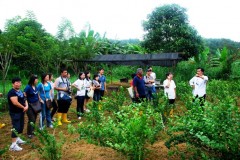
Stuff that we use in the farm to repel insects, to reduce fungal attacks, to boost the immune system of the chickens and to generally make the farm a place that first time visitors feel 'energised'.
15:21 Posted in Visitors | Permalink | Comments (0) | Tags: farm visit, organic farm visit, ecogreen
Nov 28, 2009
Raya Korban At The Farm
A goat was sacrified for Raya Korban yesterday at the farm; in commemoration of Prophet Abraham's willingness to sacrifice his son as an act of submission to the will of God.
Muslims at the farm from Indonesia, Myanmar and Bangladesh participated. Pak Cik Razaly, the farm manager, presided.
The chosen animal was strong, healthy and one of the best in the herd.
It was treated with great respect; gently led rather than pulled or pushed.
Care was taken that it was not stressed, the knife was hidden from its eyes, and it was gently blind-folded and made to face the kiblah.
Recently I saw a program on Astro of an organic farm in the UK where the intention of the owner was to bring urbanites to his farm to experience 'real' life, including the butchering of animals for food as opposed to buying them off the shelf in sanitary packs.
There was a scene where a stunner was used on the cockerel that they were intending to butcher. I could clearly see the suffering and pain the cockerel went through as it was being stunned.
It must be painful and traumatic to be stunned to unconsciousness!
Here, in the farm, I could see very clearly that the animal felt little if any pain at all. In fact a research done by Wilhem Schulze, a professor in veterinary medicine, in 1978 indicates that ritual slaughtering of animals may be more humane than modern methods.
I am impressed with the respect that was accorded the animal yesterday, and for this fact alone, in my opinion, we should not participate in modern commercialised meat production as a consumer.
11:22 Posted in Blog | Permalink | Comments (0) | Tags: aidil adha, raya korban, ritual slaughtering
Nov 09, 2009
New Waterfall
We entered into an area of the forest where no human have entered before (or at least, not for a long, long while). The 'feel' is different. There was no sense of 'fear' from the jungle. We felt 'protected', and being 'embraced' and one feels a reluctance to leave. There were no mosquitoes, no disturbances. Only the quiet peace of a 100 million year old rain forest.
The forest that we entered looking for a water source for our farm:
We reached the area after following a series of newly discovered small waterfalls rising over 100 meters. We named the falls 'Air Terjun Wahyu / Wahyu Falls' after Ali Wahyudi our Indonesian Technical Adviser who first discovered the falls.
How long ago was it when the first hominid appeared? 8 million years?
Is it not possible for another intelligence, another 'awareness' to have developed in our rain forests over the 150 million years of its existence ?
I must go back to the peace of the rain forest ....
10:42 Posted in Blog | Permalink | Comments (5) | Tags: waterfalls. rain forest
Nov 05, 2009
Caviar of the East - The Newly Weds Came
On 30th Oct we switched on the sounds on a permanent basis. Today, we noticed the droppings of at least 10 pairs of newly weds. This must surely break all records for the time it takes for the walit to take up home in a man-made structure.
The walit in a farm like DQ provides a useful function in keeping the insect population low. We first noticed the walit when we were scratching our heads as to why our honey bees just keep on disappearing. Then we put two and two together.
Completed walit house plus garden.
15:49 Posted in Blog | Permalink | Comments (3) | Tags: swiftlet farming, walit
Nov 02, 2009
Lovely Mimosa
The forest around the farm never fails to surprise me. After 20 years you would have thought I have seen it all. Then suddenly this lovely mimosa appeared. Recently it was a strange passiflora.
What a lovely mimosa (click on pics to enlarge).
The seeds with a single wing.
The distinctive mimosa leaves.
The fruits.
17:10 Posted in Blog | Permalink | Comments (0) | Tags: mimosa
Sustainable Farming - A Model
To be sustainable, inputs must be less than outputs. Inputs include fuel and all forms of energy, labour and raw materials. Even treatment of wastes must not consume excessive energy. For a farmer to practice sustainable agriculture, he must derive a reasonable income from his efforts.
This is a model for sustainable agriculture we developed at our farm (click to enlarge):
This how an acre of land may look like (click to enlarge):
We calculated a net income of RM3000 to RM5000 per month is possible from such a farm.
10:22 Posted in Sustainable Farming | Permalink | Comments (3) | Tags: sustainable farming, sustainable agriculture
Oct 31, 2009
Warriors In Our Midst
There are warriors in my midst; fighting thankless battles on our behalf.
Click here or on the banner to go to the blog.
10:26 Posted in Blog | Permalink | Comments (0) | Tags: eco warriors









